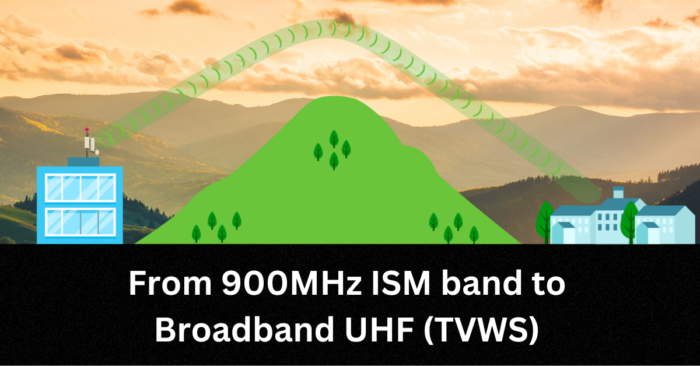
A case for moving from the crowded 900MHz ISM band to Broadband UHF (TVWS)
Navigating the wireless spectrum can be difficult for operators, particularly within the 900MHz Industrial, Scientific, and Medical (ISM) band. Though this band has been a workhorse, it has become unusable in most areas due to crowding and interference. A potent alternative emerges in using UHF Broadband (TVWS), offering many advantages in terms of noise management, capacity, range, and reliability.
1. Alleviating the 900 MHz Crowding: Migrate to UHF Broadband (TVWS)
a. An Overburdened 900MHz ISM Band:
Once prized for supporting long-range and near-line-of-sight communications, the 900MHz ISM band is now hardly usable in most areas. Unfortunately, the band has become overcrowded with a plethora of sensors and devices, resulting in escalated noise levels and reduced communication quality.
b. Breathing Room with Broadband UHF (TVWS):
“TV White Space” refers to unused spectrum in the TV bands, typically UHF channels ranging from 470MHz to 698MHz. Using TVWS frequencies versus 900 MHz can mitigate congestion, providing operators with a cleaner, less noisy spectrum to deploy their services.
2. Enhancing Capacity with TVWS
a. Harnessing Untapped Potential:
The availability of TVWS provides a robust platform that can accommodate more capacity per user and devices. Given the better propagation characteristics of the UHF band, operators can harness the capacity of TVWS to facilitate stable and scalable connectivity solutions, especially in remote or underprivileged areas.
b. Channel Bonding for Increased Capacity:
Typical TVWS regulations allow four bonded channels. While the channel size is 6MHz in North America, other countries have 8MHz TV channels. So, channel bonding is usually allowed up to 24 MHz; increasing bandwidth can improve capacity for target rural and remote connectivity for people and machines.
c. TVWS aligned with the latest ATSC3 Broadcast Standard:
Globally, the regulators are adopting the new ATSC3 standard, allowing TV broadcasters to repurpose their analog signal to Digital and higher capacity signal. However, they still need an uplink solution. Hence, regional operators such as WISP can provide the uplink to the broadcasters with TVWS and assign a new additive channel for network investment monetization, unavailable with 900 MHz.
d. TDD for optimum use of the spectrum for digital divide and IOT:
Globally, the regulators have adopted TDD vs FDD for TVWS. This aligns very well with the digital divide and IOT use cases, as the duty cycle of the TDD can be set for the best optimization.
3. Increased Range and Penetration
a. Formidable Propagation:
The frequencies within the TVWS band have inherently superior propagation characteristics, capable of transmitting signals over longer distances and effectively penetrating obstacles like buildings and foliage. The TVWS spectrum could be the only tool left capable of Non Line-of-Sight transmission which made it a unique solution.
b. Remote Connectivity:
This enhanced range enables operators to establish and maintain connectivity in rural and underserved areas, bridging the digital divide with more equitable access to communication services.
4. Unparalleled Reliability with Reduced Interference
a. A Pristine Canvas:
An underutilized spectrum presents a relative interference-free environment. This results in more reliable communication for applications requiring robust connectivity, such as emergency services, industrial IoT, and telemedicine.
b. Dynamic Spectrum Access:
Using geo-location databases and cognitive radio technologies allows devices to dynamically access the TVWS, ensuring optimal use of the available spectrum. The TVWS Dynamic Spectrum Access enhances network reliability by avoiding interference with protected services, such as TV broadcasting and wireless microphones. The use of dynamic spectrum will help prevent what happened in the 900MHz.
5. Leverage existing infrastructure
TVWS devices can leverage your existing infrastructure. You can use the same towers and the same remote site structure. TVWS is an ideal migration tool for 900MHz users with a simple CAP & GROW strategy. Migrate to TVWS gracefully without involving much civil and construction work.
6. Regulatory and Technological Developments
Embracing TVWS is becoming progressively viable due to the ongoing advancements in regulatory frameworks and technological developments. Authorities worldwide recognize the potential of TVWS and are progressively establishing guidelines to facilitate its utilization for broadband and other wireless applications.
Final Thought
While the 900MHz ISM band has traditionally been a linchpin in rural and remote wireless communications, the burgeoning demands of the connected world necessitate a pivot towards more controlled, sustainable, scalable, and reliable solutions. TVWS stands out as the most formidable contender, promising operators a path towards less noise, more capacity, and a more robust, reliable wireless future with TVWS.
Tapping into the untapped, TVWS represents a fresh arena where operators can innovate, creating wireless solutions that are technically superior and instrumental in ushering in a more connected, inclusive, and digitally equitable world for people and machines.
Migrating critical 900MHz applications to TVWS is a sound decision, and many will come to that conclusion with time: the early adopters will have much more spectrum at their disposal than the ones that procrastinate and do it later.
Please get in touch with us for information on the positive impact of moving from 900MHz to TVWS and the associated coordination.







